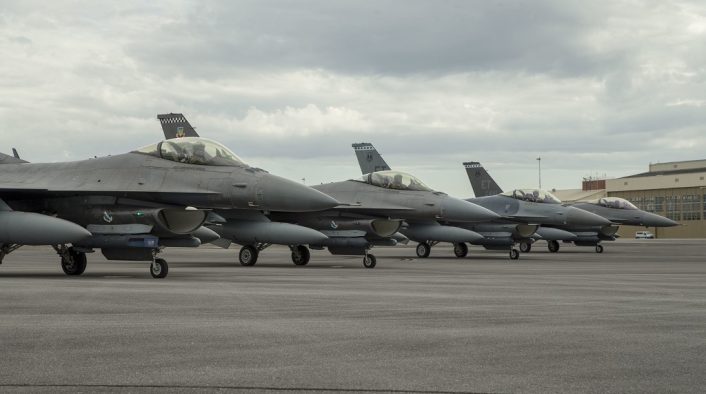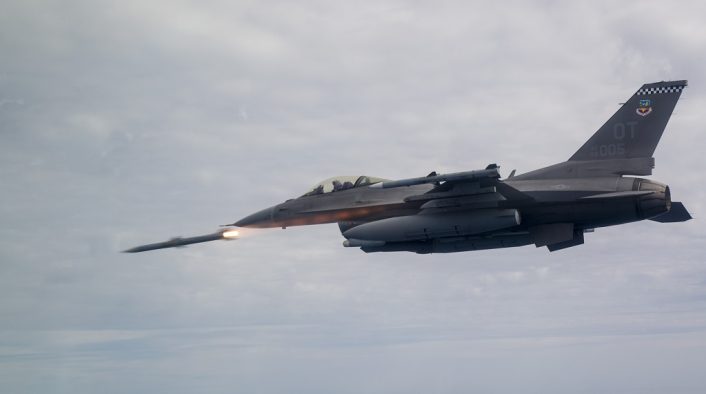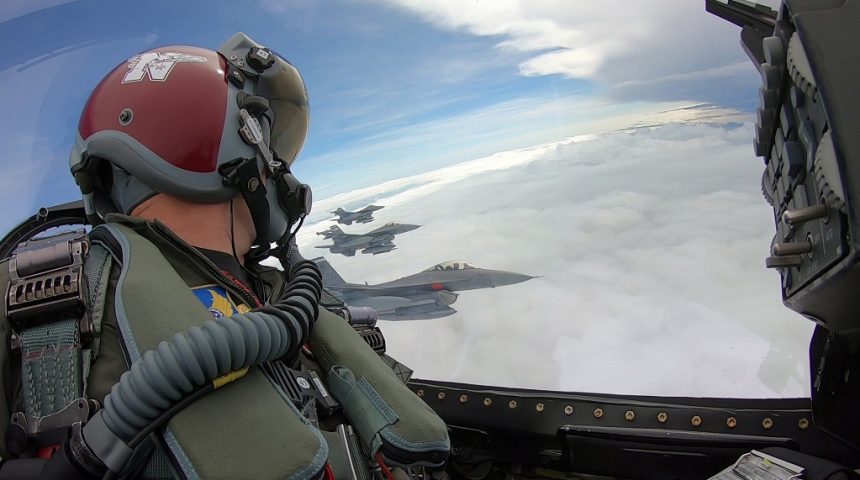The jets from Eglin AFB performed the test to assess the behavior of multiple APG-83 radars in close proximity during simulated combat missions.
The U.S. Air Force performed for the first time a four-ship flight test mission with F-16CMs equipped with the new AN/APG-83 SABR (Scalable Agile Beam Radar) AESA (Active Electronically Scanned Array) radar. The test was performed on July 2, 2020 at Eglin Air Force Base (Florida) by the Operational Flight Program Combined Test Force, 40th Flight Test Squadron and the 85th Test and Evaluation Squadron, which are the units responsible for testing and fielding the new radar and other F-16 upgrades. Multiple F-15 Eagles were also involved in the test.
According to the press release, “The radar equips F-16s with 5th generation radar capabilities similar to F-22s and F-35s. The system is used in the suppression or destruction of enemy air defenses, to include targeting radars and surface-air-missiles. It also improves existing air-to-air capabilities and enhances air-to-ground mapping.”
The new capabilities were also explained by Jack Harman, 40th FTS F-16 fighter test pilot: “This capability allows us to target the northwest corner of a small building or the cockpit of an aircraft from several miles away, beyond line-of-sight. [The radar] improves our ability to identify the threat prior to us being targeted – we no longer have to be inside a threat envelope in order to detect it.”
The four-ship flight, meaning four aircraft flying together, is the basic fighting formation for fighter aircraft during combat operations. The goal of the test was to assess the behavior of the radar during this type of scenarios, with four aircraft in close proximity, and verify if the four radars interfere with each other, degrading he signal, or if they work better, improving the signal.

The aircraft involved in the test were:
- F-16CM-40 88-0441, 40th FTS, ET tail code, Have Glass V paint scheme;
- F-16CM-50 91-0396, 40th FTS, ET tail code, standard (older) Have Glass II paint scheme;
- F-16CM-50 98-0004, 85th TES, OT tail code, Have Glass V paint scheme;
- F-16CM-50 98-0005, 85th TES, OT tail code, Have Glass V paint scheme.
Other than the standard loadout of two 370-gallon external fuel tanks, inert AIM-120C, AIM-9X and AN/ASQ-T50 pod (used for combat simulation during training), all Vipers flew with both the AN/AAQ-33 Sniper Advanced Targeting Pod (ATP) and AN/ASQ-213 HARM Targeting Systems (HTS). The two pods are reportedly integrated with the APG-83 and their sensors can be “slaved” (technical term describing the ability of the sensors to be cued to the area scanned by the radar, usually indicated by the radar cursor on the MFD) to the radar, a capability inherited from the more recent versions of the APG-68 and Operational Flight Program (OFP) software currently installed on the F-16.
As a side note, 98-0005 is the same F-16 that shot the first AIM-120 AMRAAM (Advanced Medium-Range Air-to-Air Missile), reportedly the latest AIM-120D variant, using the APG-83 radar and the new M-series 7.2+ software in 2019.
The F-16 OFP M-series 7.2+ software was released in April 2020 to more than 600 F-16CMs (all variants from Block 40 to Block 52), after more than 4,200 sorties and 4,600 flight hours at Eglin AFB. The new software allowed the integration of the APG-83, which will be operational across the F-16 fleet by the end of the year, the improved AGM-158B JASSM-ER (Joint Air-to-Surface Standoff Missile-Extended Range) and AIM-120D, an Integrated Communication Suite, and 42 other unspecified modernization enhancements.
According to Capt. Justin R. Marsh, F-16 OFP Lead Engineer, “the upgrades bring reduced pilot workload, enhanced close air support weapons accuracy, increased lethality, and improved projected mission effectiveness rates”. The upgrade also reportedly increased the reliability of the F-16s Modular Mission Computer.
The M7.2+ tape, as the OFP if often referred to by pilots and maintainers, was the first to be completely developed in-house by the Operational Flight Program Combined Test Force, with the final preparation for the software release being done also using remote telework due to the COVID pandemic. This OFP is also the last to use a legacy software development approach known as “waterfall”. From now on, the development will be done by using an open source approach called DevSecOps, as part of a Department of Defense initiative to unify software development (Dev) with “baked-in” cybersecurity (Sec) and software operation (Ops). According to the Air Force, this approach will allow shorter development cycles and more frequent delivery of upgrades to the operational squadrons.

Back to the APG-83 AESA radar, Northrop Grumman won a first contract in 2017 for 72 SABR radars to upgrade Air National Guard F-16s, followed by another contract in December 2019, worth more than USD 1 billion for up to 372 radars to be completed by May 2027, that modified the first contract. The contract was modified again on February 2020, with a USD 262 million contract awarded to exercise the options to include 15 Engineering, Manufacturing and Development (EMD) and 90 production radars, as well as associated support equipment and spares.
The APG-83 radar was first tested aboard two F-16s of the 416th Flight Test Squadron at Edwards AFB between 2015 and 2016, followed by tests aboard Eglin’s jets after the contract award. According to Northrop Grumman, the radar is designed to fit the F-16 with no structural, power or cooling modifications; in addition, it enables the F-16 to detect, track and identify a greater number of targets (reportedly more than 20 at the same time) faster and at longer ranges while providing all-weather, high-resolution Synthetic Aperture Radar (SAR) mapping. The system also integrated a robust electronic protection to operate in hostile electronic environments.
The same radar is also included in the F-16 Block 70/72 configuration, that has been offered both as new aircraft and upgrade of older Blocks. The countries that are either getting new aircraft or upgrading older ones are currently Greece, Taiwan, Morocco, Bulgaria, Bahrain, with Taiwan already taking delivery of the upgraded aircraft. A Block 70 country specific configuration, called F-21, was also offered to India.









